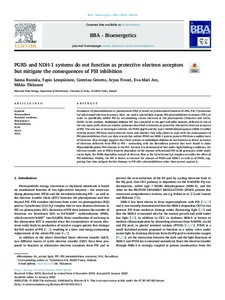PGR5 and NDH-1 systems do not function as protective electron acceptors but mitigate the consequences of PSI inhibition
Tikkanen M; Aro EM; Lempiäinen T; Gerotto C; Tiwari A; Rantala S
PGR5 and NDH-1 systems do not function as protective electron acceptors but mitigate the consequences of PSI inhibition
Tikkanen M
Aro EM
Lempiäinen T
Gerotto C
Tiwari A
Rantala S
ELSEVIER
Julkaisun pysyvä osoite on:
https://urn.fi/URN:NBN:fi-fe2021042822924
https://urn.fi/URN:NBN:fi-fe2021042822924
Tiivistelmä
Avoidance of photoinhibition at photosystem (PS)I is based on synchronized function of PSII, PSI, Cytochrome b(6)f and stromal electron acceptors. Here, we used a special light regime, PSI photoinhibition treatment (PIT), in order to specifically inhibit PSI by accumulating excess electrons at the photosystem (Tikkanen and Grebe, 2018). In the analysis, Arabidopsis thaliana WT was compared to the pgr5 and ndho mutants, deficient in one of the two main cyclic electron transfer pathways described to function as protective alternative electron acceptors of PSI. The aim was to investigate whether the PGR5 (pgr5) and the type 1 NADH dehydrogenase (NDH-1) (ndho) systems protect PSI from excess electron stress and whether they help plants to cope with the consequences of PSI photoinhibition. First, our data reveals that neither PGR5 nor NDH-1 system protects PSI from a sudden burst of electrons. This strongly suggests that these systems in Arabidopsis thaliana do not function as direct acceptors of electrons delivered from PSII to PSI - contrasting with the flavodiiron proteins that were found to make Physcomitrella patens PSI resistant to the PIT. Second, it is demonstrated that under light-limiting conditions, the electron transfer rate at PSII is linearly dependent on the amount of functional PSI in all genotypes, while under excess light, the PGR5-dependent control of electron flow at the Cytochrome b(6)f complex overrides the effect of PSI inhibition. Finally, the PIT is shown to increase the amount of PGR5 and NDH-1 as well as of PTOX, suggesting that they mitigate further damage to PSI after photoinhibition rather than protect against it.
Kokoelmat
- Rinnakkaistallenteet [19206]
